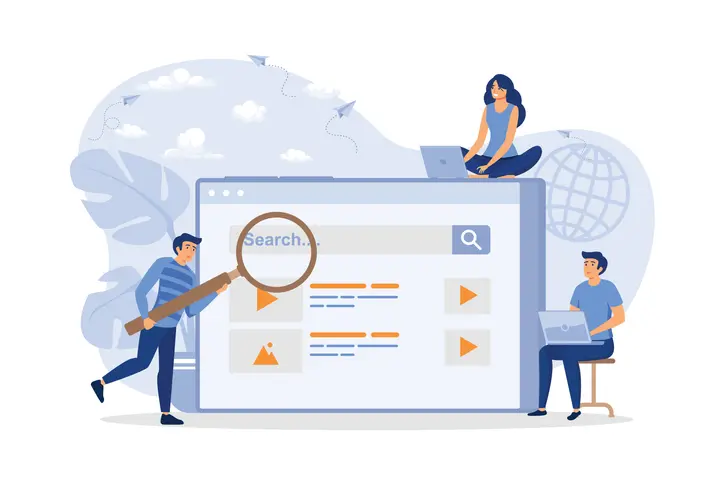
What product teams need to know as intelligent agents take the driver’s seat in digital experiences
Some shifts in technology arrive like booming thunder. Others sneak in, small and strange at first, until one day they feel inevitable.
Agentic UX is the latter.
As product teams navigate this shift, they’re stepping into a new territory: UX for autonomous AI systems, where software — not people — is often the primary user.
At its core, agentic UX is a new paradigm in digital experience design. It’s about building systems in part (or maybe primarily) for intelligent software that acts on our behalf. These AI agents aren’t just chatbots or background tools anymore. They’re evolving into independent actors that interpret intent, make decisions, and execute tasks inside your apps, platforms, and workflows.
We used to build stuff for fingers on glass. Now we’re building for invisible users who operate in loops of sense-think-do.
And the next 12 to 18 months will define how well we make the leap.
TL;DR:
UX design is entering a new era: one where AI agents — not humans — are the users. This article explores what product teams need to know to design systems that support autonomous AI agents, from API clarity and structured data to explainability and agent-aware UX tooling. The next 12 months will define how well we adapt.
The market is betting big on AI agent experience design
If you want a litmus test for a trend’s staying power, follow the money.
Salesforce’s Agentforce — an AI suite for automating enterprise productivity — is launching expanded features in April 2025. This is a strategic platform move.
IBM, in its own 2025 business trends report, projects that companies are moving from pilot AI programs to enterprise-scale deployments and that training the workforce to collaborate with AI will be a core challenge.
Statista projects the agentic AI market will reach $5.1 billion by 2025. Another report puts the 2030 estimate at $120 billion.
Meanwhile:
- The global chatbot market will hit $1.25 billion in 2025.
- The AI-powered design tool market — the backbone of AI agent experience design — is growing at 19.6 percent CAGR, and it’s on track to reach $26.5 billion by 2033.
- The broader UX design software market is expected to hit $10.7 billion by 2033, up from just $4 billion today.
What does this tell us? Agentic UX isn’t replacing the old UX economy, rather it’s expanding it.
This expansion signals an urgent need for UX for autonomous AI systems. This is an approach that re-imagines how experiences are structured, delivered, and interpreted by intelligent agents.
UX for autonomous AI systems: Rebuilding the digital house
Here’s the twist: AI agents don’t use your interface the way people do.
They don’t scroll. They don’t hover. They don’t get confused when you bury a link.
AI agents don’t use your interface like humans do. And that’s exactly why UX for autonomous AI systems requires rethinking everything from API design to data formats.
They operate through APIs, navigate data structures, and evaluate pathways based on logic, not intuition. Designers are now facing a new frontier: UX for autonomous AI systems, where usability isn’t judged by visual clarity but by how effectively intelligent software can understand and act on your product’s architecture.
That means designing for AI agents looks more like systems architecture than screen design.
A good AI agent experience design starts with:
- Standardized APIs with predictable, consistent endpoints and methods.
- Machine-readable data using formats like JSON-LD, combined with semantic vocabularies like schema.org.
- Clear documentation tailored not just for human devs, but for machine parsing.
- Agent-first onboarding, where the agent has a defined role, a purpose, and access to clean, relevant training data.
In short: your UX can’t stop at the front-end. It needs to speak machine, fluently.
UX for autonomous AI systems: Designing for software, not screens
How UX professionals will adapt to the agentic era
Let’s address the elephant in the room: Is agentic UX going to automate UX jobs?
Not quite. But it is going to change them dramatically.
UX researchers are already feeling the shift. Tools like Looppanel and Maze use AI to:
- Transcribe and summarize interviews
- Identify behavioral patterns
- Optimize A/B test setups
- Automate survey analysis at scale
Rather than displacing researchers, AI allows them to move faster and go deeper. With grunt work offloaded, UX teams can refocus on emotional resonance, strategic insights, and ethical oversight.
UX designers are seeing a similar shift. AI now helps:
- Generate layout ideas and wireframes
- Auto-resize and adapt assets for responsive design
- Simulate journeys for different user intents
But here’s what’s new: designers must now account for AI agents as users. That means thinking about how software navigates systems — not just how humans do.
In the near future, successful UX professionals will:
- Collaborate closely with AI engineers
- Master prompt and response architectures
- Evaluate experiences not just for usability, but also for agent interpretability
And they’ll do all this while maintaining the human-centered heart of design.
Interfaces are melting — and that’s the point
Welcome to the “Zero UI” era. We’re already living it:
- Microsoft Copilot drafts your meeting recap.
- Google summarizes your search results.
- Spotify shapes your music queue without a prompt.
This isn’t just UI streamlining. It’s interface bypass. As we move into 2025, expect a rise in:
- Multi-agent orchestration, where teams of specialized agents handle tasks in tandem, like a digital crew with one conductor.
- Adaptive UIs, where layout and content shift based on predicted needs and past behavior.
- Conversational UX, powered by LLMs, where user interaction feels more like dialogue than navigation.
All of this collapses the friction that traditional interfaces used to carry. Agentic UX is about giving users tools as well as outcomes.

What could go wrong? Plenty, if we’re not careful
Agentic UX is powerful. But with great automation comes great responsibility.
Data privacy is the most urgent concern. AI agents need data — lots of it — to perform well. But that opens the door to misuse, leaks, and overreach. Without transparent policies, consent flows, and ethical handling, trust evaporates.
Bias is another minefield. If an agent is trained on skewed data, it will act on skewed assumptions. That can manifest as unfair recommendations, discriminatory responses, or harmful patterns—at scale.
Explainability becomes non-negotiable. Users (and regulators) will demand clarity on why an agent did what it did. That means building systems that can surface rationale in human language, with visual context or traceable logic.
The good news? Designers are uniquely equipped to solve this. We already know how to translate complexity into clarity.
Real-world use cases you’ll see in the next 12–18 months
This isn’t a future-tense conversation. Agentic UX is live.
- Salesforce Einstein AI is suggesting actions for sales reps in real-time.
- Microsoft Copilot is embedded in Office 365, summarizing docs and emails.
- Amazon and Walmart are automating warehouse and inventory optimization with agents.
- Sephora and Olay are using AI agents to offer hyper-personalized product recommendations.
- Levi’s is improving supply chain forecasting using predictive agentic models.
- Netflix and Spotify are fine-tuning personalization through behind-the-scenes autonomous curation.
The common thread? Each one replaces manual decision-making with software that makes decisions for the user.
What to expect next
Here’s what’s coming:
- Agentforce expands (Q2 2025): Salesforce deploys more vertical-specific agentic tools.
- Rise of orchestration platforms: Agent-to-agent coordination moves into enterprise apps.
- Agent-aware UX tooling launches: Design software with built-in testing for agent compatibility becomes mainstream.
- More transparency mandates: Expect regulation around explainability, especially in finance, health, and hiring.
- Creative-AI partnerships strengthen: New roles emerge for prompt engineers, agent architects, and AI behavior designers.
If you’re a UX professional, now’s the time to skill up, because your new colleagues aren’t human.
Frequently asked questions about UX for autonomous AI systems
What is agentic UX?
Agentic UX is the design of systems for autonomous AI agents — software that acts on behalf of human users. It prioritizes structured data, API consistency, and machine readability over visual interface design.
Why do AI agents need a different UX approach?
AI agents don’t interact visually — they parse data, follow logic, and act based on APIs. If the system isn’t structured clearly, agents fail silently, impacting human outcomes.
Are designers being replaced by agentic UX?
No — but roles are evolving. Designers are shifting toward collaboration with AI engineers, focusing on intent modeling, explainability, and ethical interaction design.
What are real-world examples of agentic UX?
Products like Salesforce Einstein, Microsoft Copilot, and AI-powered supply chain tools already rely on AI agents to make decisions and drive actions for users.
What skills should UX professionals develop for this shift?
Understanding of prompt engineering, API design, structured data formats (like JSON-LD), AI system behavior, and agent onboarding will become core UX competencies.
Final thoughts: Design for the user you can’t see
The agentic UX era is already here.
It’s in your inbox. Your customer support queue. Your analytics dashboard. It’s the layer of intelligence you won’t see but that will increasingly shape how users experience your product.
Design is now screens as well as systems. Specifically, it’s about crafting UX for autonomous AI systems — digital environments optimized for AI agents who interpret, decide, and act.
And if your systems don’t make sense to your digital coworkers, your human users will feel the fallout. Because when the agent struggles, the outcome suffers.
The best products of the next 12 months will quietly, invisibly, and intelligently work for and through users.
Are you designing for that world?
Want to stay ahead of the agentic UX curve?
At Standard Beagle, we help product teams design systems for both humans and AI. If you’re building the future, we’d love to be your UX partner.











